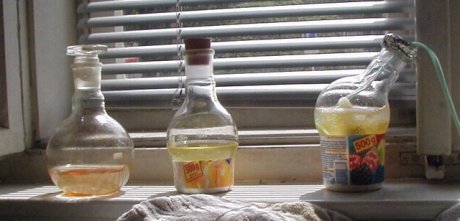| Pages:
1
2 |
Polverone
Now celebrating 21 years of madness
        
Posts: 3186
Registered: 19-5-2002
Location: The Sunny Pacific Northwest
Member Is Offline
Mood: Waiting for spring
|
|
Remember, I acidified the ethanol with hydrochloric acid before adding H2O2 to the iron/copper/ethanol mixture. Acidic H2O2 is much more stable. The
copper will be attacked, but the H2O2 doesn't undergo plain catalytic decomposition: there were no bubbles and the temperature rose far too much
for it to be from H2O2 decomposition alone (this was only 3% H2O2 solution).
Acid + H2O2 seems to be a good mixture in general for attacking stubbornly acid-resistant metals. HCl + H2O2 is often used for etching copper. The
solution turns green but there is no noticeable catalytic decomposition. Aqueous ammonia + H2O2 will attack copper as well, but the H2O2 decomposes
very rapidly under those conditions.
[Edited on 4-30-2004 by Polverone]
PGP Key and corresponding e-mail address
|
|
|
madscientist
National Hazard
   
Posts: 962
Registered: 19-5-2002
Location: American Midwest
Member Is Offline
Mood: pyrophoric
|
|
There probably was a considerable amount of aqueous chlorine participating in the reaction.
I weep at the sight of flaming acetic anhydride.
|
|
|
Organikum
resurrected
    
Posts: 2337
Registered: 12-10-2002
Location: Europe
Member Is Offline
Mood: frustrated
|
|
Uuups, my bad, I overlooked the HCl addition.......
Madscientist: The reaction is told to proceed through ferric acid.
I gave it try and added some iron/copper to EtOH and then some H2O2 10%. No heating up but bubbles. This was yesterday and it still bubbles softly at
the metal. Some stuff flocked out - copper hydroxide?
I will be strong and withstand the impuls to add acid or more H2O2, but let it sit until it ceased to bubble. Well stoppered out of direct sight....

|
|
|
Trolf
Harmless

Posts: 4
Registered: 22-4-2004
Location: Denmark
Member Is Offline
Mood: No Mood
|
|
Cu coated Fe
What is the idea behind this.
1. To let Cu do the catalysing (would Cu-powder then work just as well)
2. To release the iron in small controlled amounts as the Cu is gradually removed from its surface.
3. Or some kind of cooperative effect I cant see.
|
|
|
madscientist
National Hazard
   
Posts: 962
Registered: 19-5-2002
Location: American Midwest
Member Is Offline
Mood: pyrophoric
|
|
Hydrochloric acid and hydrogen peroxide produces a considerable amount of chlorine, and chlorine reacts readily with alcohols and such... probably two
mechanisms to it. One problem could be that the chlorine could oxidize the aldehyde to carboxylic acid much more quickly than the iron catalyst would.
I weep at the sight of flaming acetic anhydride.
|
|
|
Organikum
resurrected
    
Posts: 2337
Registered: 12-10-2002
Location: Europe
Member Is Offline
Mood: frustrated
|
|
There is a bunch of possible reactions involved here and I am neither going to try to judge which takes place at all nor which predominates under what
conditions.
|
|
|
Organikum
resurrected
    
Posts: 2337
Registered: 12-10-2002
Location: Europe
Member Is Offline
Mood: frustrated
|
|

Left: copper, iron, H2O2, EtOH
Middle: FeSO4, H2O2, EtOH and H2SO4
Right: toluene, EtOH, some ironwool, H2O2, FeSO4, H2SO4 and air bubbling through it for the soup separates into two layers. And as its an oxidation
some oxygen wont hurt I thought.

|
|
|
madscientist
National Hazard
   
Posts: 962
Registered: 19-5-2002
Location: American Midwest
Member Is Offline
Mood: pyrophoric
|
|
Just suggesting that an acid other than HCl be used.
I weep at the sight of flaming acetic anhydride.
|
|
|
| Pages:
1
2 |